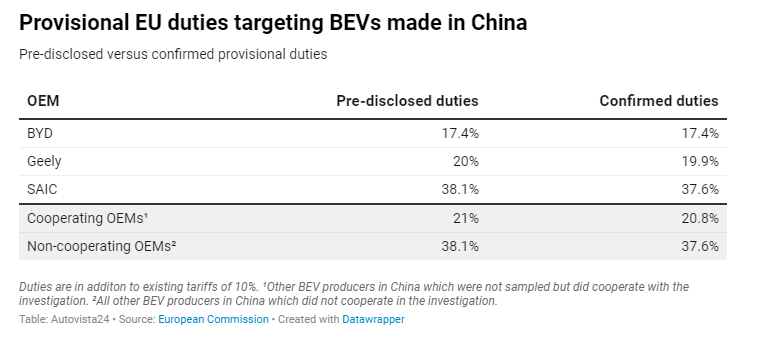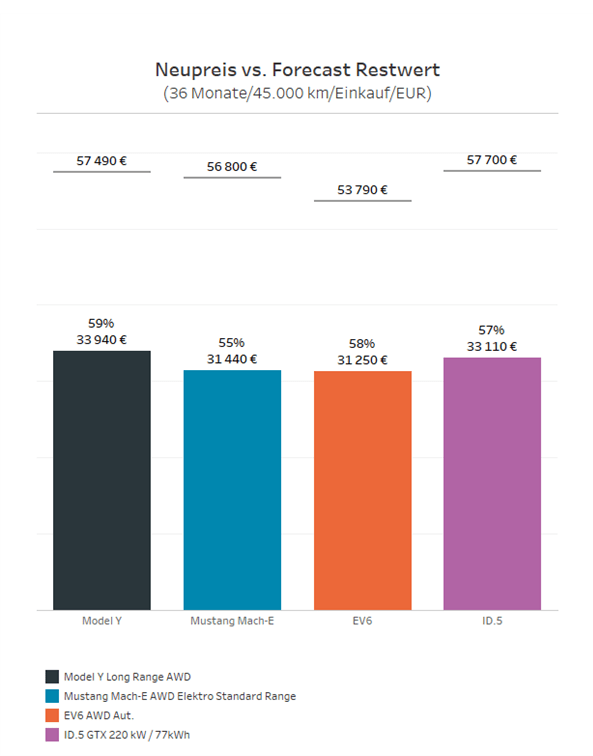Wie wird sich die Verhängung vorläufiger Zölle auf die Einfuhren von batteriebetriebenen Elektrofahrzeugen aus China auf den europäischen Markt auswirken? Im aktuellen Podcast von Autovista24 diskutieren der Redakteur Tom Geggus und unser Redakteur zu Sonderthemen Phil Curry diese Neuigkeiten.
Für in China hergestellte und in die EU eingeführte E-Fahrzeuge gelten nun vorläufig Strafzölle. Die Europäische Kommission bestätigte diesen Schritt, während die Gespräche auf Regierungsebene fortgesetzt werden. Welche Autohersteller müssen jetzt mit höheren Zöllen rechnen? Welche Auswirkungen sind auf den europäischen Automobilmarkt zu erwarten?
Abonnieren Sie den Autovista24-Podcast und hören Sie frühere Ausgaben auf Spotify auf Apple, Google und Amazon Music .
Notizen
Durchführungsverordnung der Kommission
Die wichtigsten Punkte des Papiers: Die Antisubventionsuntersuchung der Europäischen Kommission
Chinas Einfluss auf die europäische Automobilindustrie
Wie man den europäischen Markt für batterieelektrische Fahrzeuge wieder ans Laufen bringen könnte
Der Hintergrund
Nach einmonatigen Gesprächen hat die Europäische Kommission die Einführung vorläufiger Zölle auf aus China importierte E-Fahrzeuge bestätigt. Das Ziel der Maßnahme ist eine Angleichung an die Listenpreise der einheimischen KFZ-Hersteller.
Am 4. Oktober 2023 leitete die Kommission eine Untersuchung über die illegale Subventionierung von E-Fahrzeug-Wertschöpfungsketten in China ein. Am 12. Juni 2024 wurde dann nach Gesprächen mit der chinesischen Regierung der vorläufige Abschluss der Untersuchung bekannt gegeben.
Im Rahmen ihrer laufenden Untersuchung ist die Kommission vorläufig zu dem Schluss gekommen, dass die Wertschöpfungskette für batterieelektrische Fahrzeuge in China von einer unlauteren Subventionierung profitiert, durch die den Herstellern solcher Fahrzeuge in der EU eine wirtschaftliche Schädigung droht. Untersucht wurde auch, wie sich die Maßnahmen auf Importeure, User/Userinnen und Verbraucher/Verbraucherinnen auswirken können, hieß es in der Erklärung der Kommission.
Infolgedessen hat die Kommission neue Zölle angekündigt, die sie auf in China hergestellte und in die EU eingeführte E-Fahrzeuge erheben würde. Diese im Voraus bekannt gegebenen Zollsätze wurden auf der Grundlage der bei der Untersuchung festgestellten Subventionsbeträge berechnet.
Geltende Zölle
Am 4. Juli 2024 bestätigte die Kommission die vorläufigen Zölle, die sie auf jedes aus China in die EU eingeführte E-Fahrzeuge erheben würde. Seit der Vorabunterrichtung im Juni wurde der Zollsatz für viele Unternehmen leicht gesenkt. Dies war das Ergebnis von Stellungnahmen interessierter Parteien zu der Art und Weise, wie die im Voraus bekannt gegebenen Zölle berechnet wurden.

Die bestätigten vorläufigen Zölle werden zusätzlich zu den derzeitigen 10 %igen Abgaben auf Einfuhren erhoben und treten am 5. Juli 2024 für eine Dauer von höchstens vier Monaten in Kraft. Die Kommission hat bestätigt, dass innerhalb dieses Zeitraums eine endgültige Entscheidung über die endgültigen Sätze erwartet werden kann.
Dies wird nach einer Abstimmung in den EU-Mitgliedstaaten geschehen. Sollte eine qualifizierte Mehrheit von mindestens 15 Mitgliedstaaten, die mindestens 65 % der EU-Bevölkerung repräsentieren, gegen die Zölle stimmen, werden sie blockiert. Mit dem Erlass eines endgültigen Beschlusses würden die Zölle für fünf Jahre festgeschrieben.
Mögliche Ergebnisse
Laut Christoph Ruhland, Director of Business Development bei Autovista Group (Teil von J.D. Power), sind bei der Umsetzung der Zölle mehrere Auswirkungen in Betracht zu ziehen. Diese beinhalten u.a. diese möglichen Folgen:
- Chinesische Automobilhersteller könnten ihre Markteintrittsstrategien für E-Fahrzeuge in Europa zurückstellen oder einschränken. Der Grund dafür ist, dass die neuen Zölle ihre Kalkulation ändern.
- Es könnte auch zu einer Zunahme der Plug-in- und Vollhybridmodellen kommen, da diese nicht von den neuen Zöllen betroffen sind
- Die Verbraucherpreise für E-Fahrzeuge werden steigen, da die Zölle zu hoch sind, um von der Gewinnspanne aufgefangen zu werden. Das betrifft auch E-Fahrzeugmodelle europäischer Hersteller, die in China produziert werden.
- Einige Importe aus China könnten in Nicht-EU-Länder wie Norwegen und das Vereinigte Königreich oder in andere Regionen wie den Nahen Osten oder Brasilien umgeleitet werden.
- Chinesische Automobilhersteller werden zunehmend gezwungen sein, Produktionsstätten in der EU zu betreiben, um Einfuhrzölle zu vermeiden.
- Die Zölle könnten sich negativ auf die Umweltziele der EU auswirken, da sie den Zugang zu E-Fahrzeugen für die Öffentlichkeit erschweren und damit den Übergang von Verbrennungsmotoren zu E-Fahrzeugen verlangsamen.
- Sollte es zu keiner Einigung kommen, wird China höchstwahrscheinlich Vergeltungsmaßnahmen ergreifen und einen umfassenderen Handelskrieg riskieren, der der europäischen Wirtschaft (und nicht nur dem Automobilsektor) schaden könnte.
Auswirkungen auf die KFZ-Modelle
Die aktuelle Entwicklung wird Auswirkungen auf mehrere derzeit in Europa erhältliche Modelle haben. Einige Fahrzeuge in der Bestsellerliste für E-Fahrzeuge von Januar bis Mai, die mit Daten von EV Volumes erstellt wurde, werden wahrscheinlich mit Zöllen belegt werden.
Das Tesla Model 3, derzeit das zweithäufigste verkaufte Elektroauto in Europa, wird wahrscheinlich ebenfalls betroffen sein. Der US-Hersteller, dem ein Zoll von 20,8 % drohen könnte, hat allerdings eine Überprüfung mit dem Ziel eines individuellen Satzes beantragt, der im Rahmen der endgültigen Sachaufklärung eingeführt werden soll.
Der von SAIC gebaute MG4 war in den ersten fünf Monaten dieses Jahres die Nummer 7 bei den Verkäufen von Elektroautos, diesem Fahrzeug droht aktuell der höchsten Zollsatz. Auch der Volvo EX30 von Geely wird wahrscheinlich betroffen sein. Die Produktion dieses Modells wird jedoch im nächsten Jahr in Europa aufgenommen, was bedeutet, dass das Unternehmen nicht mehr belastet wird, wenn es die Produktion aus China verlagert. Der weltweit beliebteste Automobilhersteller BYD wird derzeit in der Top-20-Liste der europäischen Elektrofahrzeuge nicht geführt.
Es steht außer Frage, dass der gesamte EU-Markt für E-Fahrzeuge von den Zöllen betroffen sein wird. Die Region ist bestrebt, den Übergang zu einer emissionsfreien Mobilität fortzusetzen, wobei die Erschwinglichkeit eine zentrale Voraussetzung für die Massenmarktfähigkeit ist. Diese Zölle zwingen die Automobilhersteller jedoch zu einer Entscheidung. Entweder absorbieren sie die Zölle in ihren Kosten, was geringere Gewinnspannen bedeutet, oder sie versuchen, sie an die Verbraucher weiterzugeben. Sollte das der Fall sein, könnte der Übergang zur emissionfreien Mobilität in der Region aufgrund des Fehlens erschwinglicher Modelle erschwert werden.
Dieser Inhalt wird Ihnen präsentiert von Autovista24.
Wir möchten Sie darauf hinweisen, dass es sich bei diesem Artikel um eine Übersetzung handelt. Das Original wurde in englischer Sprache auf Autovista24 veröffentlicht. Sollte dieser Artikel kleinere grammatikalische Fehler enthalten, bitten wir, dies zu entschuldigen. Im Falle einer Diskrepanz zwischen den beiden Texten ist die englische Version maßgeblich.



 Schließen
Schließen






